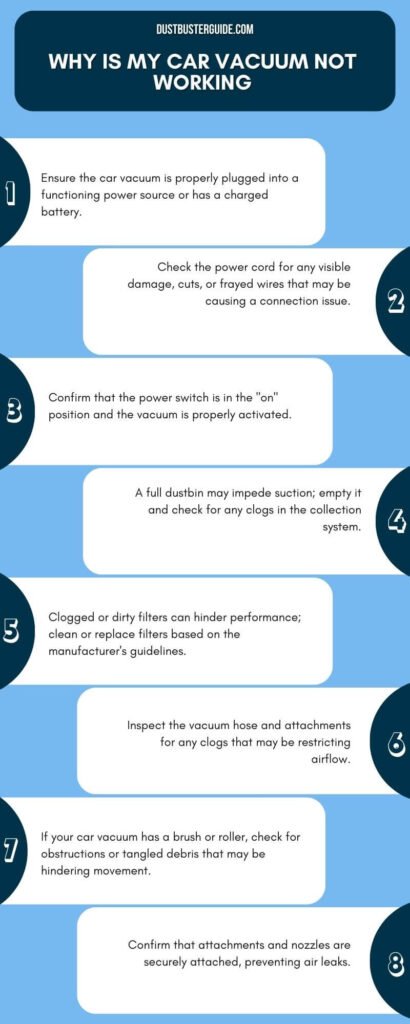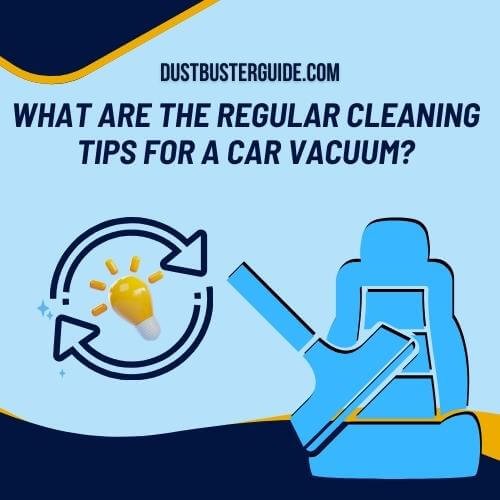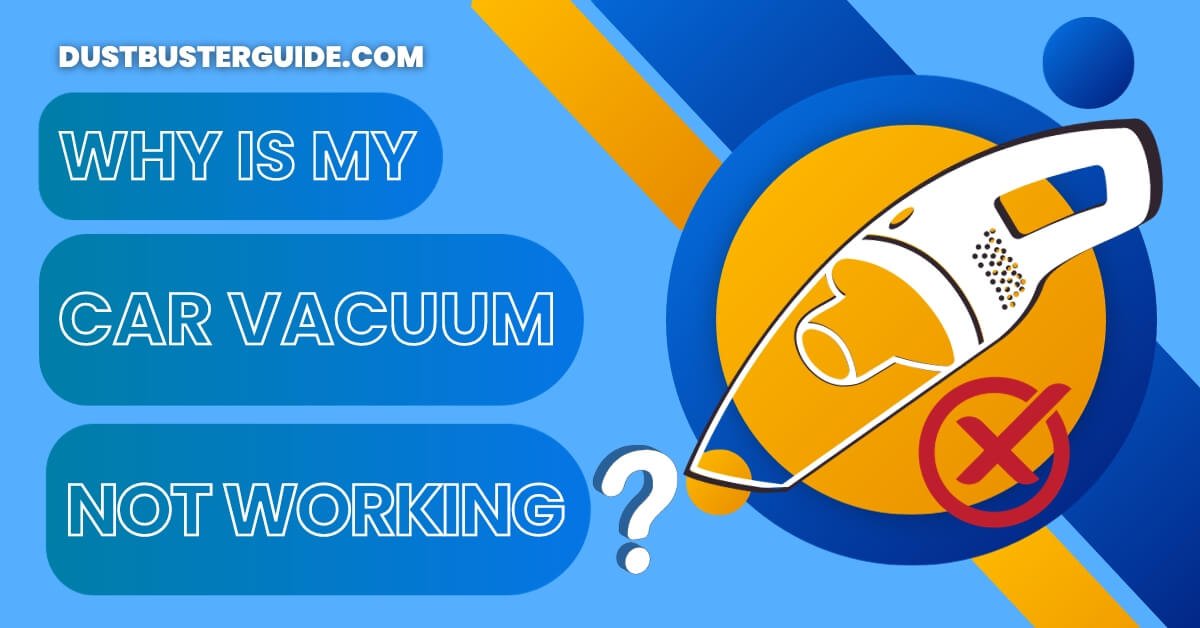Facing issues with your car vacuum’s functionality and wondering, why is my car vacuum not working?
Join us for troubleshooting insights to revive your cleaning companion. Imagine the potential solutions with a few specific considerations: 1. Check for a secure power connection. 2. Inspect the vacuum for clogs or blockages. 3. Ensure the dustbin or filter is not full. 4. Test on another power outlet.
Join us for this hands-on exploration, helping you identify and address the issues causing your car vacuum’s malfunction.
Understanding The Basics Of Car Vacuum Operation
Before we delve into why your car vacuum might not be working, let’s first get a handle on how these handy devices operate.
A car vacuum, much like your regular household vacuum, operates on a simple principle: it creates a suction force by reducing the air pressure inside its body, which then draws in air (and any debris with it) from the outside. A fan powered by a motor generates this suction force.
The dust and debris drawn in are then trapped in a filter or dust bag, while the air is expelled back out.
Understanding the key components of your car vacuum will help you troubleshoot effectively. The primary parts include the motor, battery (if it’s a cordless vacuum), dust compartment, filters, and the hose or attachments. Each part has a crucial role in the vacuum’s operation.
For instance, the motor powers the fan, which generates the suction. If any of these parts fail or aren’t functioning correctly, your car vacuum may not work as expected.
Why Is My Car Vacuum Not Working
When your car vacuum fails to function, it can be frustrating. To help diagnose the issue, consider these seven potential reasons:
- Power connection issue
- Blown fuse
- Clogged hose
- Full dustbin
- Damaged motor
- Loose connections
- Switch problems
Below, we’ll provide guidance on pinpointing the issue and resolving it. Read on to find out more.

How To Diagnose The Issue
Before you start panicking about your car vacuum not working, let’s walk you through some simple steps to diagnose the issue.
- Start by checking the filter, as a clogged one could be the culprit.
- Then, test the power source to make sure it’s not the issue.
- Finally, inspect the motor for any potential problems.
1. Checking The Filter
Let’s dive right into checking the filter of your car vacuum, as it’s often the culprit when your device isn’t working as it should.
When your car vacuum doesn’t seem to have the same suction power, it could be because the filter is clogged with dust and debris. Over time, dirt accumulates in the filter which can significantly affect the functionality of the vacuum.
So, to check, carefully remove the filter according to the manufacturer’s instructions. If it’s dirty, give it a good clean. If your filter is washable, rinse it under warm water until the water runs clear, and let it air dry completely before reassembling.
In some cases, cleaning might not be enough to restore the filter to its optimal condition, especially if it’s severely damaged or worn out. If you notice any tears or holes in the filter, or if it’s overly soiled and won’t come clean, consider replacing it. Remember, even the smallest hole can allow dust to pass through, reducing the efficiency of your vacuum.
Always keep a few spare filters on hand, so you can easily switch them out as needed. By maintaining a clean and functional filter, you’re ensuring your car vacuum can efficiently perform its job.
2. Testing The Power Source

Now that you’ve checked the filter, it’s time to test the power source of your device. The power source is a critical component of your car vacuum, and if it’s faulty, it will affect the overall performance of your vacuum.
Begin by checking if your device is properly plugged in or if the battery (if it’s a cordless model) is fully charged. If you’re using a corded vacuum, inspect the cord for any visible signs of damage. A frayed or broken cord could be the culprit behind the non-functioning vacuum.
In the case of a cordless vacuum, ensure that the battery is not only fully charged but also in good working condition. Over time, batteries can degrade and may not hold charge as effectively as they once did. If you suspect that the battery could be the issue, try replacing it and see if this resolves the problem.
If your car vacuum is still not working, then it’s time to move on to the next step: examining the motor.
3. Inspecting The Motor
So, you’ve checked the filter and power source, but what if your device’s troubles are coming from the motor itself? This is a common problem, especially with older models.
The motor is the heart of your car vacuum, and if it’s not functioning properly, neither will your device. You can start by listening to the sound it makes when you switch it on. If it’s making a buzzing or humming noise, or not making any sound at all, it might be a sign that the motor is faulty.
To further inspect the motor, you’ll need to open up your vacuum. First, make sure it’s unplugged and completely safe to handle. Locate the motor; it’s usually situated near the back of the vacuum. Check for any signs of physical damage or wear.
If you notice any wires that are frayed or disconnected, this could be the problem. Also, check for any blockages that might be preventing the motor from spinning freely. Remember, if you’re not comfortable with this level of DIY, it’s always best to consult with a professional or consider purchasing a new car vacuum.
How To Fix Your Car Vacuum
Understanding how to troubleshoot your car vacuum can save you both time and money. It doesn’t always require a professional’s help to get your gadget back to work. Sometimes, the issue could be as simple as a blocked hose or a full bag that needs emptying. Always ensure you check these aspects before concluding that your car vacuum isn’t working.
Here are some handy tips and tricks you can use:
- Regularly clean your car vacuum to prevent the build-up of dust and debris that could potentially damage the device.
- Always check your vacuum bag or bin. If it’s full, your vacuum may not work properly. Empty it and try again.
- Check for any blockages in the hose. Remove any visible debris, and if necessary, use a long, thin object to dislodge any hidden blockages.
- Ensure your vacuum is properly charged or has a good connection to the power source. If it’s cordless, make sure the battery isn’t dead. If it’s corded, check the cord for any damage or disconnects.
- Finally, check if the vacuum filter is clean. A dirty filter can reduce your vacuum’s suction power significantly. Regularly cleaning or replacing the filter can help maintain your vacuum’s performance.
Remember, regular maintenance and prompt troubleshooting can keep your car vacuum in top shape for a long time.
When To Call In The Professionals
Despite your best efforts to fix your car vacuum yourself, there may come a time when you need to call in the professionals. This is particularly true if you’ve already tried troubleshooting common issues, such as blocked filters or power supply problems, and your vacuum still isn’t working.
If you’re out of your depth or the problem seems too complex to handle, it’s best to seek professional help. A professional technician has the skills, experience, and necessary tools to diagnose and repair whatever is causing your car vacuum to malfunction.
When it’s an electrical issue, a burnt motor, or the vacuum cleaner has been damaged beyond simple repair, it’s definitely time to call in the pros. Don’t risk causing further damage by attempting to repair a complex problem yourself. A professional can quickly identify the issue and fix it, saving you time and stress.
Remember, you don’t have to do it all by yourself. There’s no shame in seeking help when it’s needed. It’s better to have your car vacuum repaired properly than to risk a subpar cleaning job or even worse, damaging your car’s interior.
How To Decide Whether To Repair Or Replace Your Car Vacuum
When faced with a malfunctioning auto vacuum cleaner, you’ll inevitably be confronted with the decision of whether to repair the unit or invest in a new one. The decision largely depends on the severity of the problem and the age of your car vacuum.
If the issue is minor, such as a clogged filter or a broken hose, it’s worth considering a repair. These types of issues can often be resolved easily and inexpensively. However, if your vacuum is older and has been giving you problems for a while, or it’s a serious malfunction like a burnt-out motor, it might be more cost-effective to replace it.
You should also factor in the cost of potential future repairs. If your car vacuum is constantly breaking down, the ongoing repair costs could soon add up to more than the price of a new unit. Think about your vacuum’s reliability and how much inconvenience the breakdowns are causing you. If you’re spending more time fixing it than using it, a new vacuum could save you time and frustration in the long run.
Remember, a functional car vacuum is an essential tool for maintaining your vehicle’s cleanliness, so it’s important to make a choice that suits your needs and budget.
| Factors | Description |
| Minor Issues | Consider repair for clogs or broken hoses. |
| Vacuum Age | Replace older units with severe malfunctions. |
| Potential Repair Costs | Factor in ongoing repair expenses. |
| Reliability and Usage | Choose based on your vacuum’s reliability and use. |
Maintaining Your Car Vacuum For Optimal Performance
Keeping your car vacuum in peak condition doesn’t have to be a chore. With some regular cleaning tips and preventive measures, you can avoid future issues and ensure your vacuum always performs at its best.
Let’s delve into how to maintain your car vacuum for optimal performance, so it’s always ready when you need it.
1. Regular Cleaning Tips

Regular maintenance of your car vacuum can significantly enhance its performance and longevity. This involves not only ensuring that the vacuum is in good working order but also cleaning it regularly. Over time, dust, dirt, and other debris can accumulate in your vacuum, causing it to work less efficiently.
Regular cleaning can help to remove these particles, improving the vacuum’s suction power and overall performance. It’s also important to empty the dust container or replace the bag frequently to prevent it from becoming too full, as this can also affect the vacuum’s performance.
There are several techniques you can use when cleaning your car vacuum. First, always unplug the vacuum before you start cleaning to ensure your safety. Then, remove any visible debris from the brushes and filters. You can use a soft cloth or a brush to clean the exterior of the vacuum and a damp cloth to clean the interior.
Be sure to dry all parts thoroughly before reassembling the vacuum. For the filters, you should follow the manufacturer’s instructions, but generally, they can be washed with warm water and a mild detergent. Remember to replace filters as necessary since worn-out filters can also impair the vacuum’s functionality.
Regular cleaning of your car vacuum is a small task that can have a big impact on its performance.
2. Preventive Measures To Avoid Future Issues
It’s crucial to take preventive measures with your auto-cleaning appliances to avoid future issues, ensuring they remain in top-notch condition for longer. Proper maintenance is not only beneficial for the device’s longevity but also for its performance.
Start by regularly checking the vacuum filter, as a blocked or dirty filter can significantly reduce the suction power. Remember to clean or replace the filter as per the manufacturer’s instructions. Also, keep an eye on the power cord and plug for any signs of damage or wear. If you notice anything unusual, it’s safer to replace them immediately rather than risk an electrical hazard.
Next, don’t forget about the vacuum bag or dust container. If it becomes too full, your vacuum’s efficiency can drastically drop. So, make a habit of emptying it after each use. Similarly, ensure that the hose is not clogged by periodically checking and cleaning it.
Lastly, store your car vacuum properly when not in use. Avoid leaving it in places with extreme temperatures or moisture as these conditions can cause damage. By taking these preventive measures, you’ll not only save yourself from the hassle of dealing with a non-working vacuum but also prolong the life of your appliance.
How Do You Fix A Car Vacuum That Won’t Turn On
To fix a car vacuum that won’t turn on, several potential issues should be checked.
First, ensure that the power cord is not damaged and that the vacuum is properly plugged into a functioning power source.
If the cord is damaged, it may need to be replaced. Additionally, if the vacuum has a container, check if it is full and clean it if necessary. The seals of the container are prone to damage, so they may need to be replaced.
For cordless vacuums, if the battery is the issue, it may need to be replaced. If these steps do not resolve the issue, it’s recommended to check the motor belt for damage and the motor itself.
If the motor or belt is damaged, they may need to be replaced. It’s important to follow the specific repair instructions for the particular car vacuum model to ensure safety and proper functionality. If the issue persists, seeking professional repair assistance may be necessary.
Conclusion
So there you found the answer to your: why is my car vacuum not working? You are now armed with the knowledge to troubleshoot and potentially fix your car vacuum. Don’t hesitate to try these tips and tricks before calling in the pros.
Remember, proper maintenance is key to avoiding these issues in the first place. But if they do arise, you’ve got the tools to handle them. Whether you choose to repair or replace, you’re making an informed decision. Good luck!
FAQs
Are there any specific brands of car vacuums that are more reliable than others?
Yes, certain brands are more reliable. Dyson, Black+Decker, and Bissell are often praised for their durability and performance. However, keep in mind even the most reliable brands can face issues if not properly maintained.
How often should I use my car vacuum for it to function at its best?
You should use your car vacuum at least once a week for optimal functioning. Regular use keeps the motor in good condition and helps prevent dust build-up that can hinder its performance.
Are there any safety concerns I should be aware of while using a car vacuum?
Yes, there are safety concerns when using a car vacuum. Be cautious not to vacuum up any liquid, as it can cause electrical issues. Also, make sure your car is off to avoid any possible accidents.
What are the environmental impacts of using a car vacuum?
Car vacuums have minimal environmental impact. They consume low energy, reducing their carbon footprint. However, improper disposal of dust and debris can harm the environment. Always dispose of waste responsibly to maintain a healthy environment.
Can I use my regular home vacuum cleaner to clean my car instead of a car vacuum?
Yes, you can use your regular home vacuum to clean your car. However, it may not be as efficient as a car vacuum, which is specifically designed to reach tight spaces and remove stubborn dirt.
How do you fix a vacuum that isn’t suctioning?
To fix a vacuum that isn’t suctioning, check for clogs in the hose or attachments, clean the filters, and inspect the brush roll for obstructions. Ensure the dustbin or bag is empty, and replace any worn parts if necessary.
How do I get my car vacuum to work again?
If your car vacuum isn’t working, check the power source (car outlet or battery), inspect the vacuum for any visible issues, and ensure all components are properly connected. If the problem persists, consult the user manual for troubleshooting tips or contact the manufacturer’s customer support.
External Resources
- Dyson Moves Into The Robot Market – 9News
- Control Strategies For Cleaning Robots In Domestic Applications: A Comprehensive Review – GitHub Pages
- Design And Manufacturing Of Automatic Classroom Vacuum Cleaning Robot – IJERT
- SharkNinja And iRobot’s Vacuum-Cleaning Robot Dispute Lands In Federal Court – THE WALL STREET JOURNAL

